Unlock the power of Node JS microservices and take your tech skills to the next level. Discover how to build scalable applications.

In today's fast-paced and ever-changing digital landscape, the demand for highly scalable and efficient software solutions has been increasing daily. This is where microservices come in, a modern architectural style that promotes the development of small, autonomous, independent services that work together to form a larger application.
Node.js is ideal for building microservices due to its non-blocking I/O model, event-driven architecture, and lightweight design. As a result, it enables developers to create high-performance, real-time applications that can easily scale and remain resilient in the face of failures.
This article will explore the advantages and disadvantages of Node.js for creating microservices architecture and best practices for designing these architectures, along with a tutorial to see how a basic microservice is implemented. If you plan to use microservices with Node.js to build efficient applications that can scale quickly, this article is perfect for you, so let's get straight to it!
What is Node.js?
Node.js is an open-source, cross-platform JavaScript runtime environment for developing server-side and network applications. The event loop at the core of Node.js allows you to manage multiple simultaneous connections quickly while remaining lightweight and resource-efficient.
The event loop works by listening to events that need to be processed, such as HTTP requests or data received from other services, and then executing the relevant code to process them. This makes Node.js an excellent choice when you need an application to respond quickly without consuming a substantial number of server or system resources.
Node also provides powerful APIs that allow developers to easily create web servers and networked applications with just a few lines of code. This makes the node especially attractive for real-time applications such as chats, online games, live updates, etc.
Additionally, Node.js uses asynchronous programming practices, which helps keep the entire application non-blocking. If one part of the application takes longer than expected, other parts will not be affected.
What is a microservice?
A microservice is a type of software architecture that bases an application on a collection of loosely coupled services. These individual services are built around business capabilities and can be deployed independently through fully automated deployment pipelines. According to research by Statista , it was found that around 81.5% of companies use microservices architecture. Each service runs in its own process and communicates with other services through well-defined APIs, typically using a system-wide HTTP/REST interface.
Microservices are small, independent processes that communicate with each other to form complex applications. They are often categorized into a monolithic architecture. They can be written in different programming languages and use different data storage technologies, so they are highly decoupled and testable software units, facilitating unit testing.
When to use Node.js microservices?
When deciding whether or not to use the node.js microservice, it is important to consider all of your application's requirements and architecture. If you have an existing monolithic application that needs scalability and performance improvements, breaking it into smaller independent services can be beneficial if the cost of migration is acceptable. Microservices should also be used when new features need to be developed quickly but do not require changes to other parts of the system, such as webhooks, notifications, or analytical processing services. Thus dividing the software components.
In cases where low latency is critical, Node may not always be suitable because its single-threaded nature means that CPU-intensive tasks will block all other requests until they complete execution, which can negatively impact performance under high load conditions compared to more traditional architectures. such as Java EE or .Net Core applications running on multiple threads simultaneously.
Asynchronous programming patterns should also be employed whenever possible in node service implementations so that I/O intensive tasks do not completely block incoming requests while waiting for responses from external services such as databases or third-party APIs, etc.
Overall, Node js has proven to be useful in building distributed systems that require high throughput at scale and relatively low resource usage.
However, there are still some disadvantages associated with using the Node.js microservice that should also be taken into consideration before making a decision:
- Limited language support – because Node is built on JavaScript, only developers familiar with this language can effectively build and maintain these types of systems;
- Lack of maturity – While there are many frameworks around node development such as ExpressJS, KoaJS, etc., many lack certain features found in more established languages.
- Security vulnerabilities – node modules tend to have limited security reviews compared to packages written in other languages, meaning malicious code can go undetected if proper checks are not done during development;
- Error handling and debugging – Troubleshooting errors in large distributed systems made up of many small nodes can be difficult, especially when dealing with asynchronous operations on different nodes.
Additionally, deciding whether or not to use the Node.js microservice largely depends on your specific requirements as well as the type of expertise you have available among your team members.
Whereas, understanding how to best utilize javascript microservices requires some experience in working with JavaScript-based server-side technologies like Express JS or Koa JS etc.
If done correctly, the benefits achieved using this approach can far outweigh any associated disadvantages if you understand its limitations and implement appropriate safeguards where necessary.
Implementing microservices with Node.js
This tutorial explores a use case for creating a language translation microservice with the Google Translate API. It is also critical to adhere to the best security standards when developing a Node.js application. So, when it comes to ensuring the security of your Node.js applications, Node.js security best practices can help you protect your data.
Context
The Google Translate API is a robust language translation API that provides real-time cross-language text translation. It also allows users to translate text on the website without developing native translation capabilities by integrating this external API into a microservice.
Let's start.
Prerequisites
Step 1: Sign up for a Google Cloud account
To use the Google Translate API, you need to have a Google Cloud account. Sign up for a free account at
Step 2: Activate Google Translate and get the API key
After signing up for a Google Cloud account, you must enable the Google Translate API in the Google Cloud Console. Follow these steps:
1. Access the Google Cloud Console at
2. Select your project or create a new one
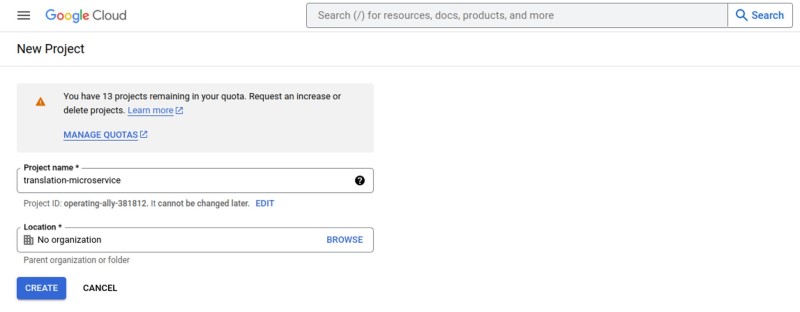
3. Click the navigation menu icon (☰) and select APIs and services > Dashboard

4. Click Enable APIs and services
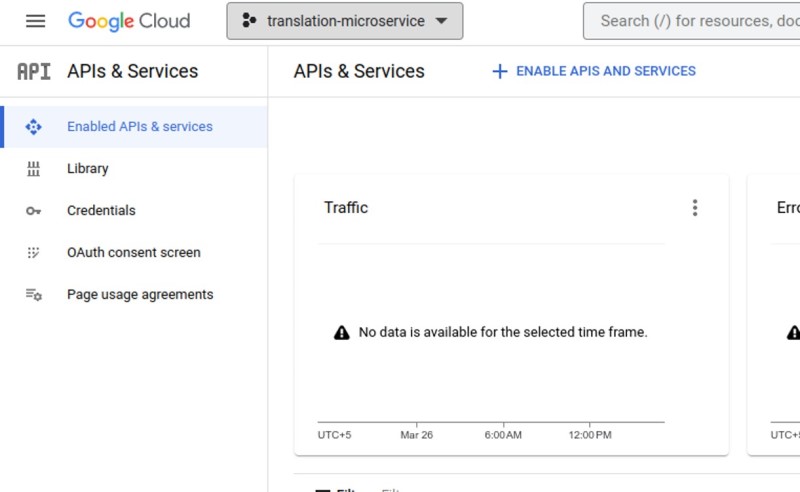
5. Search for Google Translate API and click on it


6. Click Enable

7. Generate an API key by clicking Credentials > Create credentials
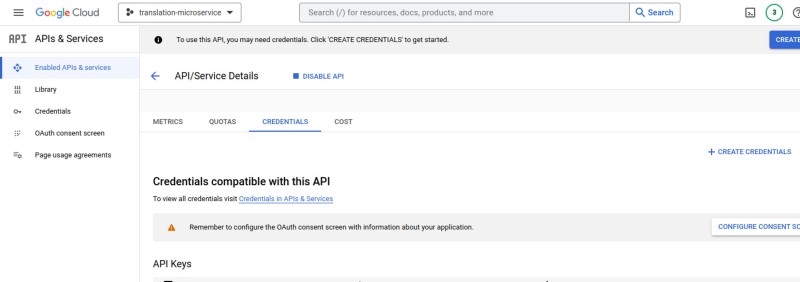
8. Copy the API key to be used later in our application.
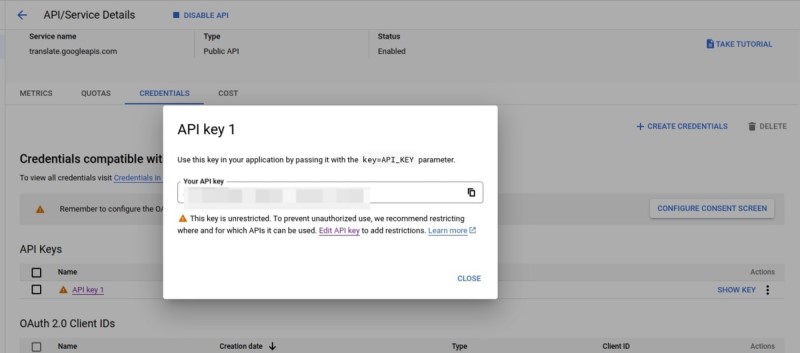
Step 3: Create a Node.js project.
Create a new Node.js project by running the following command in your terminal.
mkdir translation-microservice cd translation-microservice npm init
The npm init command is used to initialize a Node.js project.
Step 4: Install dependencies and review the JSON file
Install the required dependencies for the project by running the following command
npm install express axios
This is what your package.json should look like after installing the dependencies. It's important to review the JSON file to ensure everything is configured correctly.
{
"name": "translation-microservice",
"version": "1.0.0",
"description": "",
"main": "index.js",
"scripts": {
"test": "echo \"Error: no test specified\" && exit 1"
},
"author": "",
"license": "ISC",
"dependencies": {
"axios": "^1.3.4",
"express": "^4.18.2"
}
}
Step 5: Configure the server and create the JS file
Create a new js file called server.js and add the following code:
const express = require('express');
const axios = require('axios');
const PORT = process.env.PORT 3000;
const app = express
app.get(" (req, res) => {
res.sendFile(__dirname + '/home.html', (err) => {
if (err) {
console.log(err);
res.status(500).send('Error: Unable to load page');
}
});
});
app.get('/translate', async (req, res) => {
const { text, source, target } = req.query;
console.log(text);
console.log(source, target);
const response = await axios.get(
`
);
console.log(response.data.data.translations(0).translatedText)
res.json(response.data.data.translations(0).translatedText);
});
app.listen(PORT, => {
console.log(`Server running on port ${PORT}`);
});
The code above has two routes, one to serve a home page and another to handle a translation request.
The translation route uses the Axios library to make a GET request to the Google Cloud Translation API with the provided text, source, and target language parameters. The translated text is then returned in JSON format as a response.
Step 6: Configure the environment variable
Create a new file called .env in the project root folder and add the following code:
GOOGLE_API_KEY=<your_google_api_key>
Replace
Step 7: Configure the client side
Create a new file called home.html and add the following code
<!DOCTYPE html>
<html>
<head>
<title>Translate Text</title>
</head>
<body>
<h1>Translate Text</h1>
<form>
<label for="text">Enter the text to be translated:</label><br />
<input type="text" name="text"><br /><br />
<label for="from-language">Translate from:</label>
<select name="from-language">
<option value="en">English</option>
<option value="es">Spanish</option>
<option value="fr">French</option>
<option value="de">German</option>
<option value="it">Italian</option>
<option value="ja">Japanese</option>
<option value="ko">Korean</option>
<option value="pt">English</option>
<option value="ru">Russian</option>
<option value="zh">Chinese</option>
</select><br />
<label for="to-language">Translate to:</label>
<select name="to-language">
<option value="en">English</option>
<option value="es">Spanish</option>
<option value="fr">French</option>
<option value="de">German</option>
<option value="it">Italian</option>
<option value="ja">Japanese</option>
<option value="ko">Korean</option>
<option value="pt">English</option>
<option value="ru">Russian</option>
<option value="zh">Chinese</option>
</select><br /><br />
<button type="submit">Translate</button>
</form>
<br />
<p>Translated Text: </p>
<div></div>
<script src="
<script>
$(document).ready(function {
$('#translate-form').submit(function (event) {
event.preventDefault;
var text = $('#text').val ;
var source = $('#from-language').val ;
var target = $('#to-language').val ;
var url=" + text + '&source=" + source + "&target=" + target;
$.ajax({
url: url,
type: "GET',
success: function (data) {
console.log(data);
$('#translation').append(data);
},
error: function {
alert('Error occurred while translating the text');
},
});
});
});
</script>
</body>
</html>
The above code takes user input, sends a request object to the server, and returns a response object to the translated text using AJAX call. This will serve as the application's home page.
Step 8: Start the server
Start the server by running the following command:
node server.js
Step 9: Test the microservice
Open your browser and go to
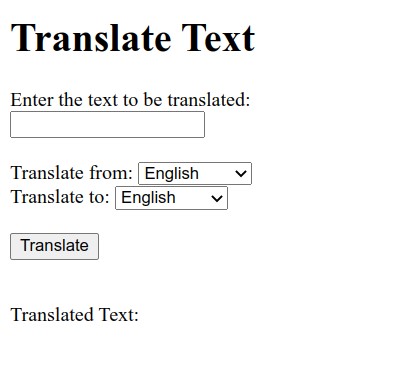
Now test the application by entering the text to be translated. You should see the translated text displayed on the screen.
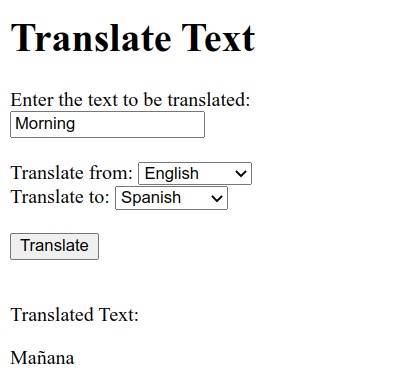
Advantages and disadvantages of using Node JS microservices
Here is a table that outlines some of the advantages and disadvantages of using microservices with Node.js.
| Benefits | Disadvantages |
| Microservices provide autonomous scalability of each service, making it easier to manage heavy traffic and large user bases. | As the number of microservices grows, so does the complexity of the overall architecture. Making it more difficult to manage and maintain. |
| Microservices can be created to manage failures intelligently, thereby reducing the impact of a single service failure on the entire system. | Because a microservice connects to others through a network, network failures and delays are more likely. |
| Because a service can be created and delivered independently of others, microservices offer faster and more frequent deployments. | Since each service must be tested and interconnected with others, developing and testing microservices requires more manpower and resources. |
Software development with microservices, the alternatives
Microservices allow organizations to break down monolithic applications into smaller, more manageable parts that can be developed and deployed independently with node.js. This strategy guarantees scalability and maintenance of the application. However, several microservices alternatives to Node.js offer similar benefits for application development and deployment.
Java
Java has been around for some time and is now one of the most used programming languages. It also includes several tools and frameworks that make it ideal for building microservices.
For example, the Spring Boot framework allows developers to quickly design production-grade microservices architectures, providing a focused view of how they should be built and deployed, significantly decreasing development time.
Go
Go (also known as Golang) is a relatively new language created by Google in 2009. However, its popularity quickly grew due to its simple yet powerful features such as garbage collection, concurrency primitives, fast compilation times, memory security, and robust community tool support.
Go makes it easy to write small, efficient programs with minimal effort, making it suitable for creating lightweight microservices that can easily be scaled up or down depending on demand or need. Its low resource usage also makes it attractive when running a large number of services in distributed cloud environments, essential when dealing with hundreds or even thousands of different services running simultaneously within a single system or across multiple nodes!
Phyton
Python is another popular language widely used among seasoned professionals and hobbyists alike, thanks to its simple syntax structure that allows for rapid prototyping, allowing developers to quickly release products without having much knowledge about coding conventions, etc.
Additionally, Python has several frameworks built specifically to support service-oriented architectures, such as Flask and Django. This helps in routing requests along specific paths between components along with adequate security in any architectural design pattern. This makes it an ideal candidate for developing microservices-based solutions.
Ruby
Ruby is often mistakenly ignored because it is too slow for server-side development. However, through the use of Ruby's EventMachine module, this myth can be debunked, allowing developers to compose high-performance asynchronous web applications capable of handling large volumes of traffic simultaneously, while providing response times that far exceed expectations. traditional 'lockdown' models.
Conclusion:
In conclusion, building microservices with Node.js, a runtime development environment based on the JavaScript programming language, has become increasingly popular in software development due to its numerous advantages. By dividing an entire application into independent microservices, development teams can work on each service separately, as detailed in the Node job description. This approach makes it easier to scale and maintain the overall application.
If you liked this article, check out our other guides below;
- Change Node Version: A Step-by-Step Guide
- Node JS Cache: Increasing Performance and Efficiency
- Unlock the power of Node.JS microservices
- Unlocking the Power of Websocket Nodejs
- Best Text Editors and Node JS IDE for App Development




















































